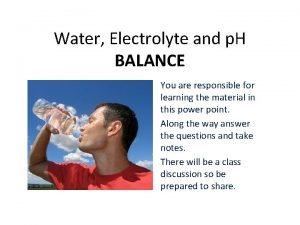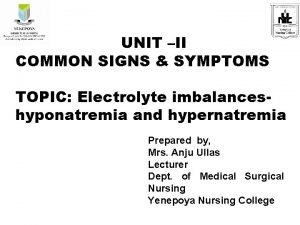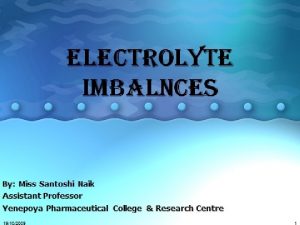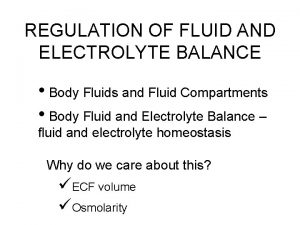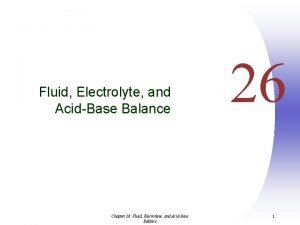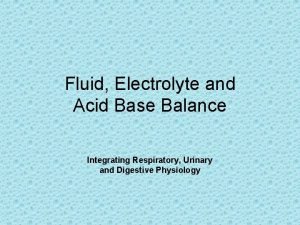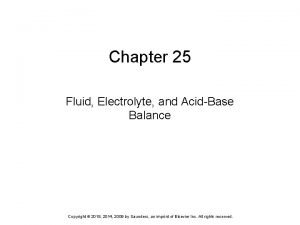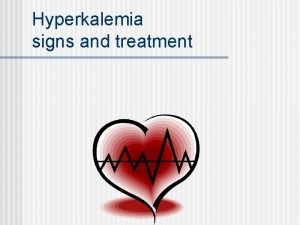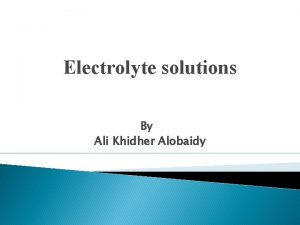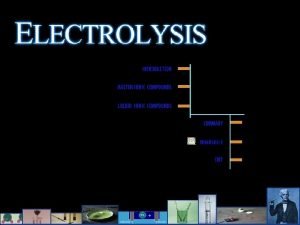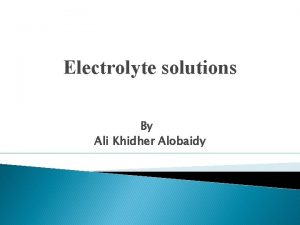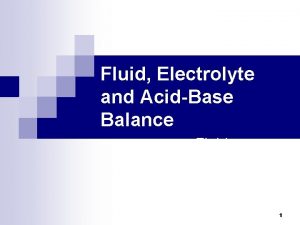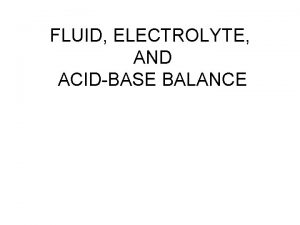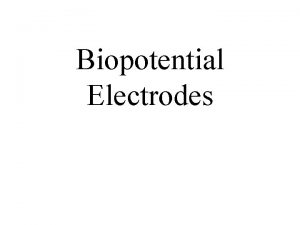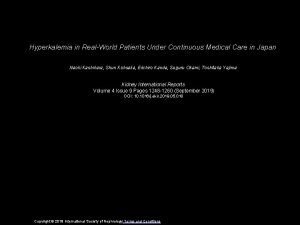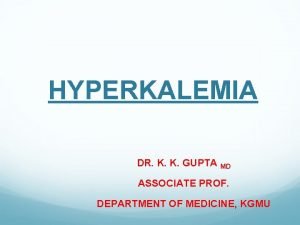The Lethal Electrolyte Part I Hyperkalemia DEFINITION Hyperkalemia




















- Slides: 20

The Lethal Electrolyte Part I: Hyperkalemia

DEFINITION: Hyperkalemia • An abnormal physiological state resulting from high extracellular concentrations of potassium. • In a homeostatic state, 98% of K+ is located in the intracellular fluid (ICF).

Normal Serum K+ Levels • Infants • Children • Adults 4. 1 -5. 3 mm/L 3. 4 -4. 7 mm/L 3. 5 -5. 0 mm/L Critical values: <2. 5 mm/L or >6. 5 mm/L

Causes • Decreased secretion or excretion as with renal failure, acidosis (K+ excretion is exchanged in the kidney for H+ in order to correct acidotic state), potassium sparing diuretics and adrenal insufficency. • Increased intake of K+ as with salt substitutes, vitamins, rapid transfusion of aged blood (lysis of dead blood cells increases extracellular K+).

Causes • Cellular shift as seen with acidotic states; sepsis, ketoacidosis and with massive tissue damage; trauma, burns or tumor lysis (causing intracelluar K+ to spill into extracxellular fluid). • NOTE: False elevations in serum K+ may occur with vigorous pumping of the hand after application of tourniquet for veinous puncture and in hemolized samples.

Manifestations • Irritability, anxiety, weakness to lower extremities, parethesia, irregular pulse and cardiac standstill if hyperkalemia is sudden or severe. • ECG changes include tall, peaked T waves, prolonged PR interval, ST depression, loss of P wave, widened QRS, VF and cardiac standstill (see fig. 1).

ECG Changes

Potassium’s Effect on Cardiac Muscle STEP 1: Rapid Depolarization Na+ channels open and Na+ floods into the cell. STEP 2: The Plateau Ca++ flows into cell via slow calcium channels, stimulating a contraction. STEP 3: Repolarization K+ escapes the cell through slow potassium channels.

Reduction of Chemical Gradient The loss of the concentration gradient in hyperkalemia inhibits repolarization of the cardiac muscle. The muscle is then paralyzed in the absence of a greater stimulus.

Hyperkalemia’s Effect on the Heart • The heart is able to function normally in a homeostatic state. • In hyperkalemia cardiac contractions become weak and irregular. • In severe cases the heart eventually stops in diastole.

Emergency Treatment • • • Insulin Glucose Ventolin Calcium Furosemide • Sodium Bicarbonate • Potassium Binding Resin • Hemodialysis

Antidotes • Insulin & Glucose: Glucose and Insulin shift K+ into cells and begin having an effect within 30 min. of administrationand lasting for 4 -6 hours after. Insulin (Humulin, Humulog, Novolin) 5 -10 U of regular Insulin IVis accompanied by Glucose (D 50 W) 1 -2 amps IV to counteract hypoglycemia NOTE: High concentrations of glucose can cause thrombosis when given peripherally. Ideally, D 50 W should be given via central line.

Beta-Antagonists • Ventolin: An adrernergic agent that increases plasma insulin levels therefore aiding in the cellular shift of K+ into the cells. This treatment is ideal in patients with renal failure where fluid overload is a concern. There are discrepancies regarding effective dosages. Anywhere from 2. 5 mg to 20 mg nebulized by mask are suggested with effects seen within 15 -30 min. and lasting for 15 min to 3 hours.

Electrolyte supplements • Calcium: Increases the threshold potential therefore restoring the cardiac muscles ability to function and counteracting the paralytic effect of hyperkalemia. Effects seen in 1 -3 min. and last 30 – 60 min. Calcium Chloride 5 ml of 10% sol. IV over 2 min. OR Calcium Gluconate 10 ml of 10% sol. IV over 2 min. YCH recently changed the vials of Calcium Gluconate so watch the dose! Caution in bradycardia

Diuretics • Furosemide: Increase the loss of K+ through the kidney. However, the effects take as long as an hour and the results are in consistent. Lasix 20 -40 mg IV slow push If patient is already taking this medications double thier daily PO dose and give IV. Large doses my be required in renal failure.

Alkalinizing Agents • Sodium Bicarbonate: Neutraizes H+ ions and raises urine and blood p. H. Onset of effect in 5 -10 min. and lasting 1 -2 hours. Sodium Bicarb 1 m. Eq/kg slow IV push or continuous IV drip Only use to treat documented metabolic acidosis or hyperkalemia-induced cardiac arrest. Blood p. H must be monitored to avoid alkalosis.

Binding Resins • Sodium Polystyrene Sulfonate: Promote the exchange of K+ for Na+ in the GI tract. Lower K+ within 1 -2 hours of administration with effects lasting 4 -6 hours. Kayexalate 25 -50 g mixed with 100 ml Sorbitol PO or PR. Multiple doses usually necessary. Kayexalate should never be given to someone with hypoactive bowel sounds because fluid shifts can lead to bowel necrosis.

Hemodialysis • Sometimes the best solution for hyperkalemia, especially in patients with known renal failure, is dialysis. This process simulates the chemical gradient within healthy kidneys and draws out excess potassium. • Most hemodialysis patients presenting with elevated K+ require dialysis for other electrolyte imbalances as well ie: elevated urea, creatinine.

Further care • Continuous Cardiac monitoring • Continuous monitoring of serum potassium levels • Correction of the cause, ie: renal failure, trauma, sepsis, acidosis. • Appropriate follow up care regarding diagnosis to prevent recurrence.

Sources Garth M. D. , D. Hyperkalemia from e. Medicine. com last updated July 25, 2001 Martini Ph. D, F. Fundamentals of Anatomy and Physiology. Prentice Hall, New Jersey, 1998. Lewis RN, Ph. D. , FAAN, S. , Heitkemper RN, Ph. D. , FAAN, M & Dirkson RN, Ph. D. , S. Medical Surgical Nursing. Mosby, Toronto, 1996. Potter, RN, BSN, MSN, P. , & Perry RN, BSN, MSN, Ed. D, A. Canadian Fundamentals of Nursing. Mosby, Toronto, 1997.
 Lethal alleles definition
Lethal alleles definition Lethal gene
Lethal gene Water electrolyte imbalance
Water electrolyte imbalance Weak electrolyte examples
Weak electrolyte examples Hf electrolyte
Hf electrolyte Refeeding syndrome electrolyte abnormalities
Refeeding syndrome electrolyte abnormalities Normal electrolyte values
Normal electrolyte values Larox dm dual media electrolyte filter
Larox dm dual media electrolyte filter Degree of dissociation of electrolyte depends on
Degree of dissociation of electrolyte depends on Blood chemistry
Blood chemistry Fluid and electrolyte balance ppt
Fluid and electrolyte balance ppt What is an electrolyte
What is an electrolyte Major physiological anions
Major physiological anions Fluid calculation formula
Fluid calculation formula An atypical accumulation of fluid in the interstitial space
An atypical accumulation of fluid in the interstitial space Anp
Anp Normal values of potassium
Normal values of potassium Lethal bac levels
Lethal bac levels Allelic interaction
Allelic interaction Lethal gene
Lethal gene Kontusio paru radiologi
Kontusio paru radiologi


